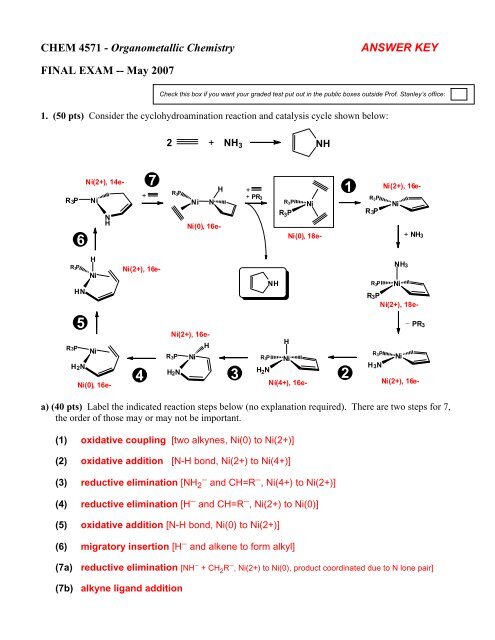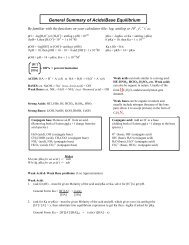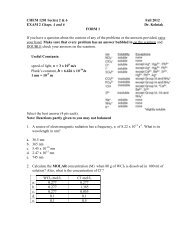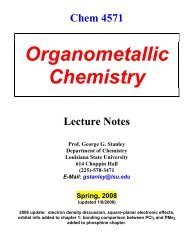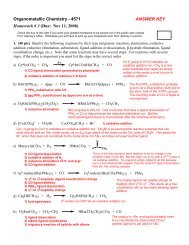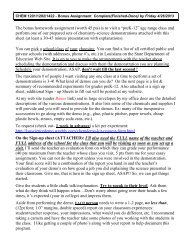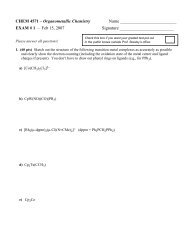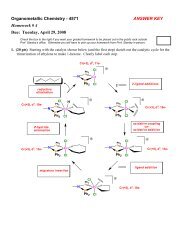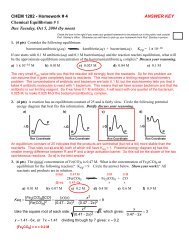Create successful ePaper yourself
Turn your PDF publications into a flip-book with our unique Google optimized e-Paper software.
CHEM 4571 - Organometallic <strong>Chemistry</strong>ANSWER KEYFINAL EXAM -- May 2007Check this box if you want your graded test put out in the public boxes outside Prof. Stanley’s office:1. (50 pts) Consider the cyclohydroamination reaction and catalysis cycle shown below:2 + NH 3 NHR 3 P6Ni(2+), 14e-NiNH+7R 3 PHNi NNi(0), 16e-+1+ PR 3R 3 P NiR 3 PNi(0), 18e-R 3 PR 3PNi(2+), 16e-Ni+ NH 3R 3PHNHNiNi(2+), 16e-NHR 3 PNiR 3 PNi(2+), 18e-NH 3− PR 35R3PNiH 2 NNi(0), 16e-4Ni(2+), 16e-HR 3 P NiH 2 N3HR 3P NiH 2 NNi(4+), 16e-2R 3 PNiH 3NNi(2+), 16e-a) (40 pts) Label the indicated reaction steps below (no explanation required). There are two steps for 7,the order of those may or may not be important.(1) oxidative coupling [two alkynes, Ni(0) to Ni(2+)](2) oxidative addition [N-H bond, Ni(2+) to Ni(4+)](3) reductive elimination [NH 2− and CH=R − , Ni(4+) to Ni(2+)](4) reductive elimination [H − and CH=R − , Ni(2+) to Ni(0)](5) oxidative addition [N-H bond, Ni(0) to Ni(2+)](6) migratory insertion [H − and alkene to form alkyl](7a) reductive elimination [NH − + CH 2 R − , Ni(2+) to Ni(0), product coordinated due to N lone pair](7b) alkyne ligand addition
Organometallics <strong>Final</strong> <strong>Exam</strong> – 2007 2H 2 NNi(4+), 16eb)(10 pts) One of the reaction steps in the catalyst cycle generates a complex that is very unusual for Nibut considerably more likely for Pd or Pt. Identify the complex (draw out the structure) and indicatewhat is unusual about it and why it would be more likely with Pd or Pt.R 3 PHNi4+ is a very high and unusual oxidation state for Ni, which rarely goes above 2+.This is due to the higher electronegativity of Ni relative to Pd and Pt, both ofwhich can readily form the 4+ oxidation state (d 6 octahedral complexes)because of their lower electronegativities.Everyone got credit for this question(unless you didn’t write anything down).2. (50 pts) The hydration of acetonitrile to produce organic amides is shown below.OH 3 C C N + H 2OHC3 C NH2a) (40 pts) Identify the one boxed mechanistic step in the catalytic cycle and draw in the three missingboxed catalyst complexes for the steps shown. You may use Cp for cyclopentadienyl. Make sure youkeep proper track of the charge(s) on the complexes drawn!NMeCNCMeIrOHHIr(3+), 18e-2++ CO 32−(deprotonation)− HCO 3−CNMeNCMeIrHOIr(3+), 18e-σ to π nitrilecoordinationchangeMeCNNIrOCCH 3HIr(3+), 18e-H 3COCNH2+ H 2O+ nitrilemigratoryinsertion2+MeCIr ONNH HIr(3+), 18e-Me+ HCO 3−(protona ti on)− CO3 2−CMeNIrNHOMeIr(3+), 18e-pr otontransferMeIrN NCIr(3+), 16 or 18e-OHMeb) (10 pts) Neutral catalysts do not work well for this reaction. Why?The cationic charge is important to enable the hydrolysis (deprotonation) of coordinated water to formthe more reactive hydroxide ligand that can do the migratory insertion with the nitrile. Neutral metalcomplexes won’t drain enough electron density from the weakly coordinated water ligand to allowdeprotonation by a weak to moderate base like carbonate. Strong bases generally won’t work herebecause they will not release the H + needed towards the end of the catalysis cycle.
Organometallics <strong>Final</strong> <strong>Exam</strong> – 2007 33. (50 pts) Hydroxycarbonylation (also referred to sometimes as hydrocarbonylation) is the catalyzedreaction of alkenes, CO and water to make carboxylic acids:OHO OR R+ CO + H2 O +HO*RRalkene isomer izationside reactionlinear (normal)Carboxylic Acidsbr anched (iso)a) (25 pts) Sketch out a catalytic cycle for this using the Monsanto/BP catalyst [RhI 2 (CO) 2 ] − andpropylene (CH 3 CH=CH 2 ) as your alkene to make the linear carboxylic acid product. HI is a cocatalystas in the Monsanto acetic acid process. The reactions steps in the proper order are as follows:1) oxidative addition of HI, 2) CO ligand substitution of propylene (clearly indicate whether this isan associative or dissociative ligand substitution rxn; this is also the rate-determining reaction step),3) migratory insertion, 4) another migratory insertion and ligand addition, 5) reductive elimination ofacyl iodide and regeneration of starting [RhI 2 (CO) 2 ] − catalyst. In a separate step outside the Rh cyclethe acyl iodide reacts with water to produce the final product and regenerate what species that reentersthe catalytic cycle?OOH+ H 2 OOI+ HIOCIRhCOIHIOCIHRhICOI- CO+OCIRhIOCOI+ 2COOCIRhIIOCIHRhIIWhen water reacts with the acyl iodide it regenerates HI, the co-catalyst for the reaction.
Organometallics <strong>Final</strong> <strong>Exam</strong> – 2007 4b) (10 pts) This catalyst system has poor linear to branched carboxylic acid selectivity (about 1:1). Whatwould be the effect of replacing a carbonyl ligand with one P(i-Pr) 3 ligand (i-Pr = iso-propyl)?Consider the effect on both the rate of catalysis and selectivity to the linear carboxylic acid. Clearlyexplain your reasoning.Everyone got credit for this question (unless you didn’t write anything down).Rate effect: Replacing one of the CO ligands with a strong donatingHalkylated phosphine will make the Rh even more electron-rich. This willR 3 P CO increase substantially the π-backbonding with the last remaining CO ligandRhand make it’s dissociation far slower. This should dramatically slow downI Ithe coordination of the alkene and slow the rate of catalysis. The oneIcompensating factor could be that the more electron-rich metal will now bemore likely to dissociate an iodide ligand. The trans-effect will specificallyfavor dissociating the iodide trans to the phosphine and coordination of the alkene at this site, whichis cisoidal to the hydride to perform the migratory insertion rxn.Selectivity: The bulkier phosphine should generally favor the hydride-alkene migratory insertion toproduce the less hindered linear alkyl product, which will then go on to form the linear acyl-iodide andcarboxylic acid. Note, however, that the magnitude of the selectivity effect may well depend onexactly where the phosphine is coordinated and how the alkene is oriented to the Rh-H bond and thephosphine directing effect. For example, if the iodide ligand trans to the phosphine dissociated, thetrans phosphine would have essentially no steric effect on the coordinating alkene for the migratoryinsertion step.c) (15 pts) It is known that HI can react directly with an alkene to produce an alkyl iodide:+ HII +Sketch out and label the reaction steps showing how CH 3 CH 2 CH 2 I could react with the [RhI 2 (CO) 2 ] −catalyst to produce the acyl iodide intermediate (not the entire cycle). Briefly discuss how (if) thiswould affect the catalytic reaction.IOCIRhCOIIoxidativeadditionOCIRhICOI1) migratoryinsertion+ CO2) ligandadditionOCIRhIOCOIWe only graded the mechanism part of this question.reductiveeliminationROIThis could actually speed up the rate of catalysis as the oxidative addition step is not dependent onan empty coordination site opening up on the catalyst as is necessary for the alkene coordination andsubsequent reaction.Extra: The bad aspect overall is the preferred formation of the branched alkyl iodide (2-iodopropane)that would react to make the branched carboxylic acid, a generally non-desirable product.
Organometallics <strong>Final</strong> <strong>Exam</strong> – 2007 54. (50 pts) Sketch out a reasonable catalytic cycle for the following reaction and clearly label eachstep. Make sure that the # of ligands on the catalyst and the electron-counting is OK. Indicate theelectron-count for each metal complex (but do NOT show the detailed electron-counting). Use thecatalyst precursor complex shown at the top of the catalytic cycle to generate your active catalyst byreaction with HBR 2 (R = non-bulky alkyl group) to eliminate CH 4 (don’t forget to label what this stepis called).hydroborationBR+ 2HBR 2Maximum points taken off = 25(unless you didn’t write anything down)Sc CH 314e-14e-catalyst precursorHmigratory inser tion+HBR 2BR 2+HBR-CH 42HydrogenolysisBR 2Sc BR 2ligand additionHydr ogenolysis14e-BR 2ScScBR216e- (B-H sigma bond)16eligandadditionScR 2B
Organometallics <strong>Final</strong> <strong>Exam</strong> – 2007 65. (50 pts) Bill Crowe’s research group (LSU Chem) has studied the following cyclocarbonylation rxn.O+ COa) (30 pts) Label the boxed reaction steps in my proposed catalytic cycle (there may be more than onereaction occurring in each step, if the order is important label them 1), 2), etc.).OOTiCOCO-COTiCOOTiCOOHoxidative additionCO additionreductiveeliminationCO addition+2COOO+CO-COTiOligand dissociationligand additionTiOOCOTiO1) migr ator y insertion2) CO ligand add itionmigrator yinsertionb) (15 pts) One might start with Cp 2 Ti(CH 3 ) 2 and react it with excess CO to produce the activeCp 2 Ti(CO) 2 catalyst and acetone (CH 3 (C=O)CH 3 ). Clearly sketch out and label the reaction steps toaccomplish this. You don’t have to draw out the Cp rings on the complexes (use Cp).TiCH 3CH 3+COligandadditionTiCH 3COCH 3migratoryinsertionTiCH 3CH 3CO+COligandadditionTiC OCCH 3CH3O1) reductiveelimination+CO2) ligandaddition+TiCOCOOH 3 CCCH 3c) (5 pts) This rxn is not really catalytic as the following reaction step is extremely slow and difficult.Why? (briefly but clearly explain)The reductive elimination to take Ti(4+), d 0 , toTiOO+2COFull credit, unless you didn’twrite anything down.TiCOCO+OOTi(2+), d 2 is difficult due to the low electronegativityof early transition metals and their preference forhigh oxidation states. This specific rxn will beespecially difficult because of the extremely strongTi-OR bond, more so than that shown above in partb) involving weaker Ti-alkyl,acyl bonds.


